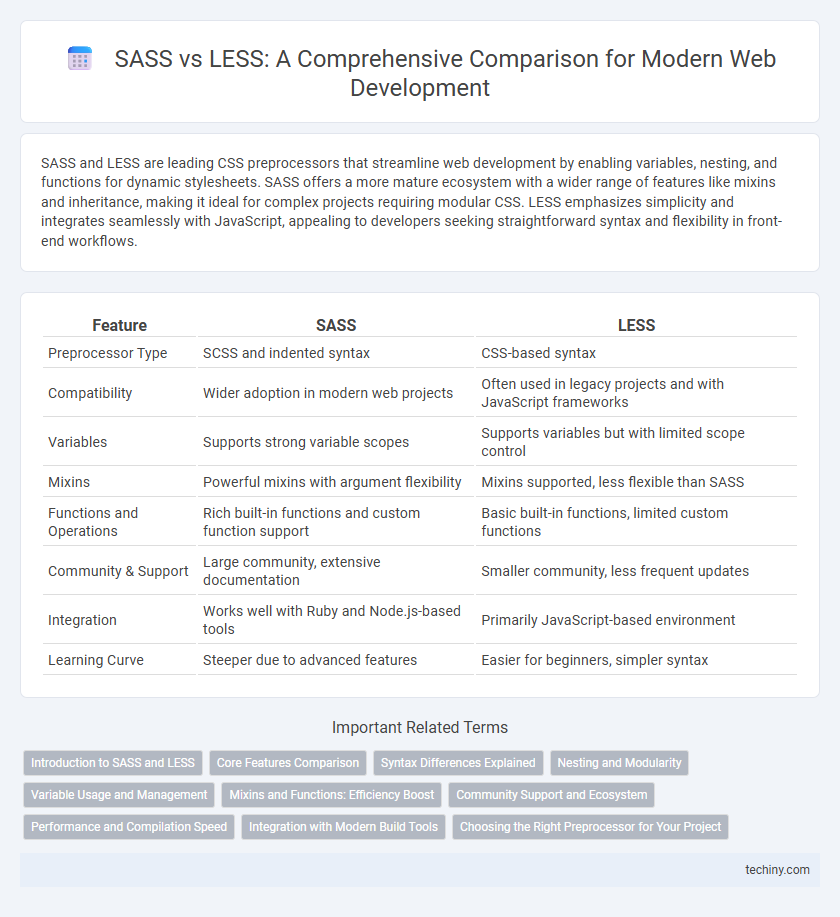SASS and LESS are leading CSS preprocessors that streamline web development by enabling variables, nesting, and functions for dynamic stylesheets. SASS offers a more mature ecosystem with a wider range of features like mixins and inheritance, making it ideal for complex projects requiring modular CSS. LESS emphasizes simplicity and integrates seamlessly with JavaScript, appealing to developers seeking straightforward syntax and flexibility in front-end workflows.
Table of Comparison
| Feature | SASS | LESS |
|---|---|---|
| Preprocessor Type | SCSS and indented syntax | CSS-based syntax |
| Compatibility | Wider adoption in modern web projects | Often used in legacy projects and with JavaScript frameworks |
| Variables | Supports strong variable scopes | Supports variables but with limited scope control |
| Mixins | Powerful mixins with argument flexibility | Mixins supported, less flexible than SASS |
| Functions and Operations | Rich built-in functions and custom function support | Basic built-in functions, limited custom functions |
| Community & Support | Large community, extensive documentation | Smaller community, less frequent updates |
| Integration | Works well with Ruby and Node.js-based tools | Primarily JavaScript-based environment |
| Learning Curve | Steeper due to advanced features | Easier for beginners, simpler syntax |
Introduction to SASS and LESS
SASS and LESS are popular CSS preprocessors that enhance stylesheet maintainability by enabling variables, nested rules, and mixins. SASS, with its SCSS syntax, offers powerful features like control directives and functions, making it widely adopted in complex web projects. LESS provides a simpler syntax and easier learning curve, commonly integrated into frameworks for rapid style development.
Core Features Comparison
SASS offers a robust feature set including variables, nesting, mixins, and functions that facilitate modular and maintainable CSS code, while LESS provides similar capabilities with a simpler syntax and direct JavaScript integration. SASS supports advanced features like control directives and expressions, enabling dynamic styling logic, whereas LESS emphasizes ease of use with its straightforward operations and built-in functions. Both preprocessors optimize CSS development workflows, but SASS's extensive core features deliver greater flexibility for complex projects.
Syntax Differences Explained
SASS utilizes a more concise and indented syntax known as SCSS, which resembles standard CSS but supports nested rules, variables, and mixins, enhancing code readability and maintainability. LESS syntax closely mirrors traditional CSS with the addition of variables, mixins, and functions, making it easier to adopt for developers familiar with CSS. Key syntax differences include SASS's mandatory indentation versus LESS's use of curly braces and semicolons, affecting how code blocks and scopes are defined within stylesheets.
Nesting and Modularity
SASS offers more advanced nesting capabilities with support for parent selectors and deeper hierarchical structures, enhancing code readability and maintainability. LESS provides basic nesting features but lacks some of SASS's modularity options like partials and imports for organizing styles into reusable components. The modular architecture of SASS, including the use of @use and @forward directives, significantly improves style encapsulation and reduces code duplication compared to LESS.
Variable Usage and Management
SASS offers a more powerful and flexible variable management system with features like default values, global and local scopes, and advanced data types, enabling cleaner and more maintainable stylesheets. LESS supports variables but lacks the extensive control SASS provides, making complex projects harder to manage when scaling. Variable interpolation in SASS allows dynamic property names and values, improving customization and reuse compared to LESS's more limited capabilities.
Mixins and Functions: Efficiency Boost
SASS and LESS both utilize mixins and functions to streamline CSS code, with SASS offering more advanced features like parameterized mixins and control directives, enhancing code reuse and maintainability. SASS functions support complex calculations and logic, enabling dynamic styling that adapts efficiently to design changes. LESS provides basic mixin capabilities but lacks the extensive function support found in SASS, making SASS the preferred choice for performance-driven web development projects.
Community Support and Ecosystem
SASS boasts a larger and more active community, resulting in extensive resources, plugins, and frameworks that enhance productivity and problem-solving. LESS, while still supported, has a smaller ecosystem and fewer third-party tools, which may limit flexibility and integration options. The robust support network around SASS often translates to faster adoption of new features and better long-term maintenance for projects.
Performance and Compilation Speed
SASS generally outperforms LESS in compilation speed due to its efficient Ruby and Dart implementations, making it faster for large-scale projects. LESS relies on JavaScript for compilation, which can slow down performance in complex stylesheets, especially in server-side environments. Performance benchmarks often favor SASS for faster rendering and smoother integration with modern front-end frameworks.
Integration with Modern Build Tools
SASS and LESS both offer seamless integration with modern build tools like Webpack, Gulp, and Grunt, streamlining the CSS pre-processing workflow. SASS provides native support through Dart Sass and node-sass, delivering faster compile times and better error reporting in complex projects. LESS integrates smoothly via dedicated loaders, but SASS's wider adoption in frameworks like Bootstrap often makes it the preferred choice for scalable, maintainable web development.
Choosing the Right Preprocessor for Your Project
Selecting the appropriate CSS preprocessor depends on project requirements and team familiarity, with SASS offering a more mature ecosystem and advanced features like nested rules and mixins, while LESS provides simplicity and easier integration with JavaScript-based environments. SASS supports a broader range of tools and is favored for large-scale projects due to extensive community support and compatibility with frameworks like Ruby on Rails. LESS can be advantageous for smaller projects or those requiring quick setup and seamless client-side compilation.
SASS vs LESS Infographic

 techiny.com
techiny.com